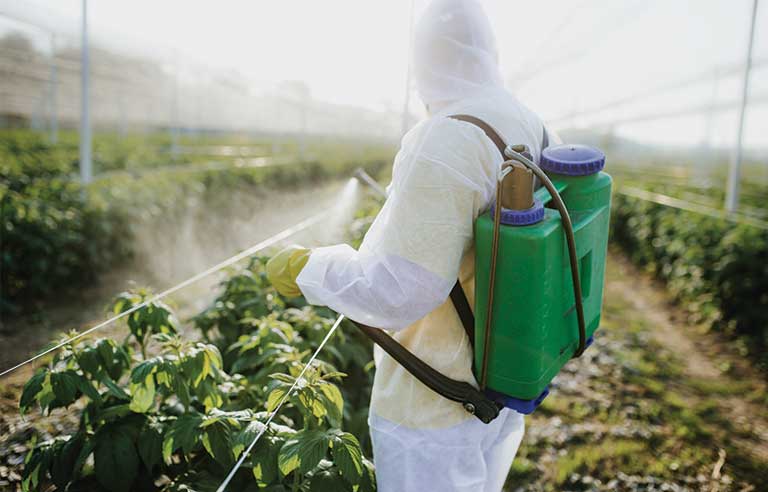Assuring worker health both increases worker productivity and aids in preventing potential microbial contamination of crops. An infected employee, whether he/she is showing symptoms or not, can easily contaminate fresh produce if they do not practice good hygiene, such as washing their hands after sneezing, touching hair or other body parts, or using the restroom.
General symptoms that flag an employee with the potential for causing microbial contamination of produce include:
- Diarrhoea
- Vomiting
- Dizziness
- Abdominal cramps
- Exposed or open wounds
- Hepatitis or jaundice (yellow colour of the skin)
Employees with gastrointestinal distress or open wounds can contaminate fresh fruits and vegetables through handling. Persons that do not show any symptoms of disease can transmit microbial pathogens. Many micro-organisms can be guests in the human body without evidence of disease and can be spread to others by the human hosts. Workers should be trained to report any disease symptoms to supervisors.
Sick employees should not participate in activities that involve direct contact with the fresh produce or with packaging material until they have clearance from a licensed healthcare provider.
Health Programs
Ideally, agricultural workers should have access to a health care system that is accessible to them in their workplace. Workers have been shown to be more willing to report symptoms of illness or disease if they have access to healthcare professionals. Information on and contact details of medical service providers that should be contacted in case of emergency must be prominently displayed.
Any worker with exposed wounds that can directly contaminate fresh produce should have these wounds properly disinfected and covered before participating in production and handling activities. A first aid kit with supplies for treating worker injuries should be readily available at the worksite.
Worker Hygiene Training Program
It is also important for employers to provide fruit and vegetable handlers with a training program on good food handling and hygiene practices. The possibility of produce contamination is directly related to the quality of the worker training program.
Proper hygiene procedures should be established and included in hygiene and health training programs. All employees including supervisors, temporary personnel, part-time and full-time workers should participate in these activities. The level of knowledge required should be set according to the type of operation, responsibilities, and type of activities in which the employee participates.
Training should be reinforced constantly. Demonstrations of procedures are usually more effective than simple verbal instructions. Training should be in the language and dialect of the employees to ensure comprehension and trainers should consider cultural aversions and ingrained practices when planning training.
Drinking-Water
Water for human consumption should be potable, which means that it should be free of micro-organisms and chemical substances that can jeopardise the health of the person consuming it. Ensuring the availability of potable drinking water for field workers can minimise the risk of them developing disease and consequently contaminating fresh produce.
Precautions that should be taken for the handling of drinking water in the fields and packing areas include:
- Water supply systems should be in good condition and operating properly.
- Water should be stored in clean, sanitised containers and tanks.
- Water containers should be washed and sanitised daily.
- Water storage containers should be closed always.
- Containers should be kept out of the sun and away from excessive heat.
- Disposable cups should be provided, and each person should use a different cup.
Frequent microbiological and physical evaluation should be performed on drinking water when the water is being stored or treated on-site. Simple evaluations of the colour, odour and taste of water should be performed as part of the daily monitoring procedures. If any of the water quality tests indicate the quality is not adequate, the water should be replaced to reduce the chances of infection and the proper authorities should be notified of the problem.
Worker Hygiene Practices and Sanitation Facilities
The responsibility for reducing or avoiding contamination during primary production falls heavily on agricultural workers. Employers can provide training and other resources to educate workers, but the effectiveness of the program, in the end, relies on the worker’s understanding and implementation of personal hygiene and safety practices.
Therefore, management should provide workers with information about acceptable hygiene practices, ensure it is understood, and send a clear signal to workers about the importance of these practices.
Hand washing is required:
- At the beginning of the workday.
- After going to the restroom.
- After smoking or eating.
- After breaks.
- After sneezing, coughing, or touching the nose.
- After touching or scratching the skin or wounds.
- After touching dirty equipment and utensils.
- After touching trash on the floor or after handling waste material.
- After touching or handling fertilisers, pesticides, chemicals, or cleaning materials.
Sanitary Field Stations
The basic requirements for sanitary field stations are:
- Toilets should be connected to an evacuation or sewage system adequately constructed to avoid contamination of fields, water sources or products.
- Sanitary stations should be good, clean, and sanitary, and should have adequate clean water, soap and paper towels.
- There should be an adequate number of toilets for the number of employees working. It is recommended that there be at least one toilet for every 20 persons of the same gender.
- Toilets should be accessible for the personnel, meaning close to their working area, at a maximum distance of 400 meters or a 5-minute walk.
- Toilet facilities should be separated by at least 400 meters from the water sources.
- Water stations with potable water for drinking should be in place during the harvest season.
